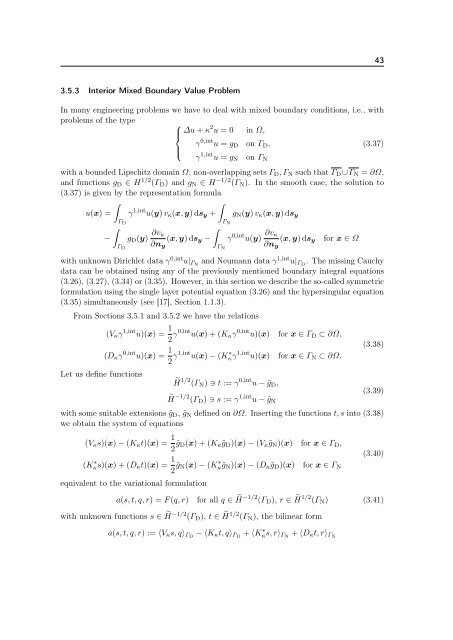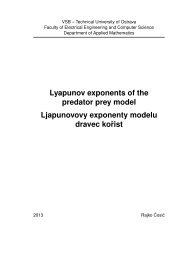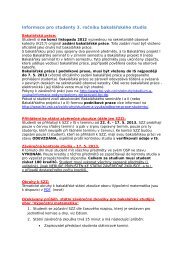The Boundary Element Method for the Helmholtz Equation ... - FEI VÅ B
The Boundary Element Method for the Helmholtz Equation ... - FEI VÅ B
The Boundary Element Method for the Helmholtz Equation ... - FEI VÅ B
Create successful ePaper yourself
Turn your PDF publications into a flip-book with our unique Google optimized e-Paper software.
433.5.3 Interior Mixed <strong>Boundary</strong> Value ProblemIn many engineering problems we have to deal with mixed boundary conditions, i.e., withproblems of <strong>the</strong> type⎧⎪⎨∆u + κ 2 u = 0 in Ω,γ 0,int u = g D on Γ D ,(3.37)⎪⎩γ 1,int u = g N on Γ Nwith a bounded Lipschitz domain Ω, non-overlapping sets Γ D , Γ N such that Γ D ∪Γ N = ∂Ω,and functions g D ∈ H 1/2 (Γ D ) and g N ∈ H −1/2 (Γ N ). In <strong>the</strong> smooth case, <strong>the</strong> solution to(3.37) is given by <strong>the</strong> representation <strong>for</strong>mulau(x) =γ 1,int u(y) v κ (x, y) ds y +Γ Dg N (y) v κ (x, y) ds yΓ N−Γ Dg D (y) ∂v κ∂n y(x, y) ds y −Γ Nγ 0,int u(y) ∂v κ∂n y(x, y) ds y<strong>for</strong> x ∈ Ωwith unknown Dirichlet data γ 0,int u| ΓN and Neumann data γ 1,int u| ΓD . <strong>The</strong> missing Cauchydata can be obtained using any of <strong>the</strong> previously mentioned boundary integral equations(3.26), (3.27), (3.34) or (3.35). However, in this section we describe <strong>the</strong> so-called symmetric<strong>for</strong>mulation using <strong>the</strong> single layer potential equation (3.26) and <strong>the</strong> hypersingular equation(3.35) simultaneously (see [17], Section 1.1.3).From Sections 3.5.1 and 3.5.2 we have <strong>the</strong> relations(V κ γ 1,int u)(x) = 1 2 γ0,int u(x) + (K κ γ 0,int u)(x) <strong>for</strong> x ∈ Γ D ⊂ ∂Ω,(D κ γ 0,int u)(x) = 1 2 γ1,int u(x) − (K ∗ κγ 1,int u)(x) <strong>for</strong> x ∈ Γ N ⊂ ∂Ω.(3.38)Let us define functionsH 1/2 (Γ N ) ∋ t := γ 0,int u − ˜g D ,H −1/2 (Γ D ) ∋ s := γ 1,int u − ˜g N(3.39)with some suitable extensions ˜g D , ˜g N defined on ∂Ω. Inserting <strong>the</strong> functions t, s into (3.38)we obtain <strong>the</strong> system of equations(V κ s)(x) − (K κ t)(x) = 1 2 ˜g D(x) + (K κ˜g D )(x) − (V κ˜g N )(x) <strong>for</strong> x ∈ Γ D ,(Kκs)(x) ∗ + (D κ t)(x) = 1 (3.40)2 ˜g N(x) − (Kκ˜g ∗ N )(x) − (D κ˜g D )(x) <strong>for</strong> x ∈ Γ Nequivalent to <strong>the</strong> variational <strong>for</strong>mulationa(s, t, q, r) = F (q, r) <strong>for</strong> all q ∈ H −1/2 (Γ D ), r ∈ H 1/2 (Γ N ) (3.41)with unknown functions s ∈ H −1/2 (Γ D ), t ∈ H 1/2 (Γ N ), <strong>the</strong> bilinear <strong>for</strong>ma(s, t, q, r) := ⟨V κ s, q⟩ ΓD − ⟨K κ t, q⟩ ΓD + ⟨K ∗ κs, r⟩ ΓN + ⟨D κ t, r⟩ ΓN









